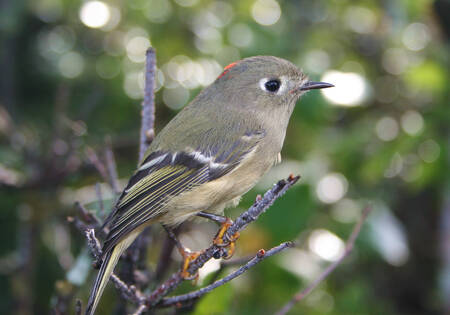
Good Natured: Extended Kinglet-Sighting Season
Pam Otto, Outreach Ambassador for the St. Charles Park District. 11/14/2024 1:00AM
The other day when I was shopping in a local establishment known for its extensive selection of adult beverages, I came across a brand I hadn’t seen in many years: Little Kings.
Back in the day, I may have been known to sample a Little King or two at various watering holes in Urbana-Champaign. I mean, how could I resist? Little green 7-oz. bottles arrayed in a bucket complete with ice. That and a few 25-cent hot dogs and this girl was set for the evening!
Forty years later the beer—or perhaps we should use its proper name, Cream Ale—is back after what seems like an extended absence, accompanied by all the slogans you’d expect from such a regal name. “Long live the King,” “It’s good to be King,” and of course “All hail the Little King.”
All this is kind of funny because, I kid you not, I’d just spent the day in search of some little kings of a different sort: members of the Family Regulidae, the kinglets. (For word fans, Regulidae is derived from the Latin word regulus, which means, ahem, little king.)
Maybe you’ve been seeing these birds too. Our extended warmth this fall has led to an extended kinglet-sighting season. Typically seen in northern Illinois in October, both golden-crowned and ruby-crowned kinglets are still popping up in numerous parks and preserves, including our Hickory Knolls Natural Area in St. Charles.
True to their name, kinglets are small--smaller even than the chickadees they sometimes associate with. To use a loosely relevant unit of measure, golden crowns weigh about as much as a US quarter, while ruby crowns weigh about as much as that quarter with a maraschino cherry stem on top (0.19 oz. and 0.24 oz. respectively).
Somewhat counterintuitively, it’s the kinglets’ teensy-ness that makes them stand out. When you’re accustomed to seeing small birds like chickadees, which weigh about the same two quarters (twice as much as a kinglet!) the size difference really does catch your eye.
Another trait that helps you notice these birds stand is their near-constant movement. They forage continuously and conspicuously, flapping and hopping around as they use their narrow beaks to glean aphids, spiders and maybe an occasional berry from trees and shrubs. In fact, even when they aren’t feeding, kinglets still move around a lot, flicking their wings and squiggling around like a sugared-up kid (or tipsy naturalist) that can’t sit still.
Such behavior provides a clue to the birds’ metabolism, which is extraordinary. That internal furnace needs continual fueling; it’s been said that kinglets will starve if deprived of food for even an hour during the day.
This time of year, the birds’ energy demands are especially high. Migration flights and cooler temperatures put an increasing demand on that metabolism to keep the bird from freezing. Behaviors like seeking shelter in dense shrubbery, as well as huddling—sitting close together within those shrubs—help conserve heat on cold nights.
As birds who breed in northern spruce and pine forests, where even springtime temps are low, kinglets are no strangers to cold. Golden crowns, whose breeding territory stretches up into northern Canada, have developed some especially interesting reproductive strategies to deal with such extreme conditions.
For one, they build their nests near the tops of conifers like spruce and fir, situating the structures close to the trunk so the there’s plenty of cover. If it snows, all the better—the white stuff insulates the birds from even-colder air.
For another, they produce very large clutches, as many as 11 eggs stacked in two layers in the tiny nest. And that’s where things get really interesting. Once the female begins incubating, the male takes on the role of provider, bringing food to his mate and, eventually, his new family. But then, just when the young are no longer in need of brooding, or warming, by the female, and you think Mama will get a few minutes to herself, she takes off and starts a completely new nest.
This phenomenon, called double-clutching, helps golden-crowned kinglets reproduce in sufficiently high numbers that their mortality rate, which also is high, doesn’t wipe the species out.
If seeing a kinglet would make your day, head out now to a high-quality woodland and keep your eyes open. Ruby crowns are olive green with a white wing bar and prominent white eye ring. But that crown? Don’t count on it. Only the male has one, and he flashes it only occasionally. Golden-crowned kinglets are more boldly marked, with both sexes having a crown (orange in males, yellow in females) bordered in black.
Should you catch a glimpse of kinglet, whether ruby crowned or golden, watch them as they flit and flutter regally among the branches. I’ll bet you, like me, will quickly fancy these delightful little kings.
Pam Otto is the outreach ambassador for the St. Charles Park District. She can be reached at potto@stcparks.org.

